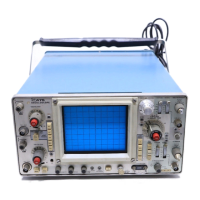TM 11-6625-2735-14-1
Troubleshooting
the Horizontal Amplifier. The
Horizontal Amplifier contains push-pull circuitry that can
be checked in the following manner:
Set TIME/DIV to 1 ms (lock knobs) and set TRIG MODE
to SINGL SWP. Remove Q1114, Q956 and Q1026 from
their sockets. Connect a voltmeter between the base of
Q1152 and the base of Q1162; adjust R1130 for 0 volt.
Check the voltages in the amplifier against the voltages
listed on the Horizontal Amplifier schematic diagram.
Check the voltage at the bases of Q1124 and Q1134 for
balance and apply this balance check procedure to each
stage, proceeding toward the amplifier output.
Install Q1114, Q956 and Q1026 in their sockets and
check for a repetitive sweep.
Troubleshooting the Vertical System. The instrument
front panel TRIG VIEW control provides a quick way to
find trouble in this circuitry. Press the TRIG VIEW
pushbutton and adjust A TRIGGER LEVEL control to
bring the trace to the crt viewing area. If unable to obtain a
trace, look for a problem in the Vertical Output Amplfier. If
a trace can be obtained, look for a problem in the Channel
1 or Channel 2 Preamplifier or the Vertical Channel
Switching circuitry.
When troubleshooting the vertical deflection system,
the best procedure is to start from the input and work to
the output of the problem-circuit area (determined by
previous checks using TRIG VIEW pushbutton).
Preamplifier Troubleshooting
The following procedure can be used for Channel 1 or
Channel 2 Preamplifier. Channel 1 is described as an
example to identify circuit functions.
Remove any external signal from the instrument input.
Check the input of U120 (pin 13) for 0 volt. Connect a
voltmeter between pins 5 and 9 of U120 and adjust CH 1
VAR BAL (R110) for 0 volt. Measure from pin 5 or 9 of U120
to ground and check for the recommended voltage listed
on the appropriate Vertical Preamp schematic diagram.
Connect the voltmeter between pins 5 and 9 of U140
and adjust CH 1 VOLTS/DIV BAL (R135) for 0 volt.
Measure from pin 5 or 9 of U140 to ground and check for
the recommended voltage on the diagram. Check the
collectors of Q172 and Q182 for voltages listed on the
diagram.
Connect the voltmeter between the collectors of Q178
and Q188 and adjust the vertical POSITION control for
0 volt. Measure from the collector of Q178 or Q188 to
ground and check for voltages listed on the diagram.
Vertical Channel Switch Troubleshooting
The collector voltages of Q178 and Q188 must by
balanced as detailed in the preceding steps before starting
this procedure.
Set VERT MODE to CH 1 and check the dc voltages in
the channel switching circuitry for the voltages listed on
the Vertical Channel Switching schematic diagram. Do
not check waveforms until dc operation is normal.
Vertical Output Amplifier Troubleshooting
Disconnect the delay line connection on the Vertical
Preamp board. This requires the use of a soldering iron (a
40 to 60 Watt iron works best) to unsolder the delay line
ground connection.
Check for the recommended voltages listed on the
Vertical Output Amplifier diagram.
Troubleshooting the Z-AXIS Circuit (CRT Circuit).
Set
TIME/DIV to 1 ms (lock knobs) and set TRIG MODE to
SINGL SWP. Disconnect and lift one end of CR1343.
Check the voltage at TP1364 for approximately +6 volts.
Press the BEAM FINDER pushbutton and check the
voltage at TP1364 for approximately +25 volts. If these
voltages cannot be obtained, check the voltage across
VR1362 for approximately +6.2 volts. Remove Q1362 from
its socket and check the voltage at the base of Q1352 for
approximately +1.3 volts. Check the base of Q1344 for
approximately +0.6 volt.
If the above-mentioned voltages can be obtained,
disconnect and lift one end of CR1341. Check the voltage
swing at the collector of Q1338 for approximately
+7.8 volts to –1.3 volts while turning INTENSITY control
from full counterclockwise to full clockwise. If these
voltages cannot be obtained, check the voltage at the base
of Q1338 for –1.75 volts. Remove Q1332 from its socket.
Disconnect J1333 and J1334 (coaxial-type end-lead con-
nectors) from their sockets. Repeat the voltage swing
check at the collector of Q1338 as performed previously.
Connect J1333, J1334, CR1343 and CR1341 to the
circuit board. Install Q1362 and Q1332 in their sockets.
CORRECTIVE MAINTENANCE
Introduction
Corrective maintenance consists of component
replacement and instrument repair. Special techniques
required to replace components in this instrument are
given here.
4-18

